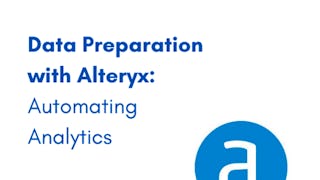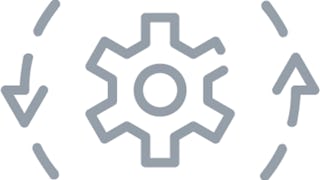This is the third course in the Google Data Analytics Certificate. As you continue to build on your understanding of the topics from the first two courses, you’ll be introduced to new topics that will help you gain practical data analytics skills. You’ll learn how to use tools like spreadsheets and SQL to extract and make use of the right data for your objectives, and how to organize and protect your data. Current Google data analysts will continue to instruct and provide you with hands-on ways to accomplish common data analyst tasks with the best tools and resources.


您将学到什么
Explain what factors to consider when making decisions about data collection.
Discuss the difference between biased and unbiased data.
Describe databases with references to their functions and components.
Describe best practices for organizing data.
您将获得的技能
要了解的详细信息

添加到您的领英档案
29 项作业
了解顶级公司的员工如何掌握热门技能

积累 Data Analysis 领域的专业知识
- 向行业专家学习新概念
- 获得对主题或工具的基础理解
- 通过实践项目培养工作相关技能
- 通过 Google 获得可共享的职业证书

该课程共有5个模块
A massive amount of data is generated every single day. In this part of the course, you will discover how this data is generated and how analysts decide which data to use for analysis. You’ll also learn about structured and unstructured data, data types, and data formats as you start thinking about how to prepare your data for analysis.
涵盖的内容
9个视频10篇阅读材料6个作业1个插件
Before you work with data, you must confirm that it is unbiased and credible. After all, if you start your analysis with unreliable data, you won’t be able to trust your results. In this part of the course, you will learn to identify bias in data and to ensure your data is credible. You’ll also explore open data and the importance of data ethics and data privacy.
涵盖的内容
12个视频4篇阅读材料6个作业
When you analyze large datasets, you’ll access much of the data from a database. In this part of the course, you will learn about databases, including how to access them and extract, filter, and sort the data they contain. You’ll also explore metadata to discover its many facets and how analysts use it to better understand their data.
涵盖的内容
10个视频13篇阅读材料12个作业
Good organizational skills are a big part of most types of work, especially data analytics. In this part of the course, you will learn best practices for organizing data and keeping it secure. You’ll also understand how analysts use file naming conventions to help them keep their work organized.
涵盖的内容
3个视频3篇阅读材料4个作业1个插件
Having a strong online presence can be a big help for job seekers of all kinds. In this part of the course, you will explore how to manage your online presence. You’ll also discover the benefits of networking with other data analytics professionals.
涵盖的内容
2个视频4篇阅读材料1个作业
获得职业证书
将此证书添加到您的 LinkedIn 个人资料、简历或履历中。在社交媒体和绩效考核中分享。
位教师

提供方
从 Data Analysis 浏览更多内容
 状态:免费试用
状态:免费试用 状态:免费
状态:免费 状态:免费试用
状态:免费试用 状态:免费试用
状态:免费试用
人们为什么选择 Coursera 来帮助自己实现职业发展




学生评论
22,909 条评论
- 5 stars
81.94%
- 4 stars
14.74%
- 3 stars
2.37%
- 2 stars
0.47%
- 1 star
0.47%
显示 3/22909 个
已于 Aug 8, 2023审阅
I love how the course it's not limited to teach about the technical skills of a data analyst professional, but it also helps you discover some soft skills that make you a better human resource.
已于 Jul 7, 2023审阅
Great course about Prepare Phrase of Data Analysis, this course explain more about Data as types, structures, how to organize, protect data and basic guide about SQL syntax and interface of BigQuery
已于 Dec 31, 2021审阅
I liked that some assignments had me use SQL and get more comfortable using it. However I would have liked more assignments using SQL and Sheets to get more practice. Otherwise was pretty fun.
常见问题
Data is a group of facts that can take many different forms, such as numbers, pictures, words, videos, observations, and more. We use and create data everyday, like when we stream a show or song or post on social media.
Data analytics is the collection, transformation, and organization of these facts to draw conclusions, make predictions, and drive informed decision-making.
The amount of data created each day is tremendous. Any time you use your phone, look up something online, stream music, shop with a credit card, post on social media, or use GPS to map a route, you’re creating data. Companies must continually adjust their products, services, tools, and business strategies to meet consumer demand and react to emerging trends. Because of this, data analyst roles are in demand and competitively paid.
Data analysts make sense of data and numbers to help organizations make better business decisions. They prepare, process, analyze, and visualize data, discovering patterns and trends and answering key questions along the way. Their work empowers their wider team to make better business decisions.
You will learn the skill set required for becoming a junior or associate data analyst in the Google Data Analytics Certificate. Data analysts know how to ask the right question; prepare, process, and analyze data for key insights; effectively share their findings with stakeholders; and provide data-driven recommendations for thoughtful action.
You’ll learn these job-ready skills in our certificate program through interactive content (discussion prompts, quizzes, and activities) in under six months, with under 10 hours of flexible study a week. Along the way, you'll work through a curriculum designed with input from top employers and industry leaders, like Tableau, Accenture, and Deloitte. You’ll even have the opportunity to complete a case study that you can share with potential employers to showcase your new skill set.
After you’ve graduated from the program, you’ll have access to career resources and be connected directly with employers hiring for open entry-level roles in data analytics.
更多问题
提供助学金,



